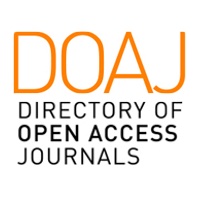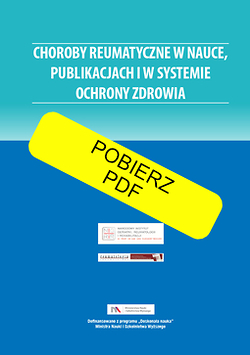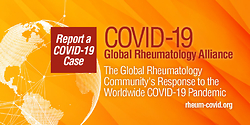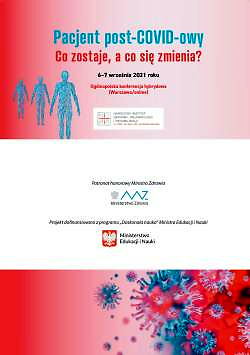|
4/2006
vol. 44
Original Paper
The critical study about the correlation of tumor necrosis factor alpha, C-reactive protein and seromucoid level in serum with parameters of disease activity in seropositive and seronegative rheumatoid arthritis patients
Barbara Olczyk-Kwiecień
,
RU 2006; 44, 4: 205-212
Online publish date: 2006/09/04
Get citation
Introduction
Rheumatoid arthritis (RA) is a complex disease with genetic predisposition closely related to autoimmunity and inflammation. Over the past 10 years our knowledge of the pathogenesis of RA especially concerning the role of cytokines has expanded substantially. Cytokines are polypeptide mediators that form a complex network of regulatory factors in systemic immune and inflammatory reactions and cellular responses at the site of tissue injury. A variety of mediators with proinflammatory properties [interleukin (IL-1), tumour necrosis factor alpha (TNF-α), IL-8, IL-6, granulocyte-macrophage colony-stimulating factor (GM-CSF), platelet-activating factor (PAF)] or anti-inflammatory properties [IL-10 and transforming growth factor β (TGF-β)] are overproduced in RA. TNF-a is of major importance in RA pathogenesis, playing an important role in both inflammatory and joint destructive pathways in RA [1-3]. TNF-α is a pleiotropic cytokine, overproduced in rheumatoid joints primarily by macrophages. It has a potential pathogenetic role in the formation of pannus and in joint damage. It increases synoviocyte proliferation and triggers a cascade of secondary mediators involved in the recruitment of inflammatory cells, neo-angiogenesis and the process of joint destruction [4]. The aim of this study is to assess a possible correlation between RA disease activity and tissue damage index and the levels of TNF, CRP and seromucoid in serum in seropositive and seronegative RA patients in comparison to OA patients.
Materials
Characteristic of patients with RA and OA
60 patients attending the Rheumatology Outpatient Department of the Central Clinical Hospital MSWiA in Warsaw with definite or classic RA according to American Rheumatism Association (ARA) criteria [5] and 30 outpatients with knee osteoarthrosis diagnosed according to ARA criteria [6] were included in the study. Waaler-Rose titre was over 8 in 30 patients (seropositive patients – group l) and below 8 in 30 patients (seronegatives – group II). Groups l and II included only patients whose X-rays showed destructive joint changes in hands and/or feet of II or higher stage according to Steinbrocker [7]. Patients with knee osteoarthrosis formed control group III. All patients gave written consent and approved the research. The study was approved by the local Research Ethics Committee. The RA seropositive group (group I) consisted of 24 women (80%) and 6 men (20%), aged from 41 years to 81 years (average 61.4±10.6 years). The RA seronegative group (group Il) comprised 25 women (83%) and 5 men (17%), aged from 23 years to 83 years (average 57.1±16.5 years). There were 25 women (83%) and 5 men (17%), aged from 41 years to 78 years (average 65.6±11.4 years) in the control group (group III). The duration of disease in group I was between 2 and 33 years (average 15.9±9.2 years), in group II between 1 and 40 years (average 9.2±8.2 years), and in group III between 2 and 18 years (average 7.3±3.9 years). Twelve patients from the control group had bilateral and 18 unilateral knee osteoarthritis. Demographic and laboratory data concerning the above groups are shown in Table I. Virtually all of the RA patients were taking nonsteroidal anti-inflammatory drugs (NSAIDs). In the seropositive-RA group 16 were taking methotrexate, 7 sulphasalazine, 5 antimalarials, 1 cyclosporine and 1 gold salt. Twenty-six (86.7%) patients were treated with low-dose prednisolone. In the seronegative-RA group 10 patients were taking methotrexate, 5 sulphasalazine, 11 antimalarials, 2 azathioprine and 2 gold salt. Twenty-four (80%) patients were treated with low-dose prednisolone. Seronegative patients were significantly younger than patients in the control group (p<0.05), while the duration of disease in seropositive patients was significantly longer than in the two other groups (p<0.001). The stage of disease progression according to Steinbrocker was dependent on the group (p<0.05). In group I (seropositive) more patients were in stage IV (16 patients = 53.3%), whereas in group II (seronegative) more were in stages II and III (respectively 4 and 20 patients, ie. 13.3% and 67%). Similarly, the average stage of disease according to Larsen-Dale [8] in the seropositive group was higher than in the seronegative one. However, the average number of painful and swollen joints and the duration of morning stiffness were the same in both groups and respectively: 4-22, average 12.5±4.3 and 2-11, average 5.2±2.0 in group l; and 3-18, average 11.5±4.3 and 1-9, average 5.3±2.3 in group II (Table II). In the control group both the number of painful and the number of swollen joints were statistically lower (8.1±4.2 and 0.3±0.7). The blood was collected from 60 RA and 30 OA patients. Blood samples were collected into tubes without additives. The blood was allowed to clot for 2 h at room temperature and then was centrifuged and stored at -80°C.
Methods
The DAS 28 [9], and VAS [10] scales were applied for evaluation of disease activity.
TNF alfa measurements
Serum TNF-alpha level was determined using an inhibition enzyme-linked immunosorbent assay (ELISA) [11].
Other analyses
The following data were estimated in all patients: erythrocyte sedimentation rate (ESR) according to Westergren, morphology of peripheral blood, level of total protein and its fractions in serum, seromucoid, C-reactive protein (CRP) alkaline phosphatase, electrolytes (Ca, P) and serum TNF-alpha level. In RA patients the presence of IgM rheumatoid factor was discovered using Waaler-Rose’s test, with over 8 as a positive result.
Radiographic method
All OA patients were examined by performing standing posteroanterior radiographs of both knee joints in semiflexion with fluoroscopic guidance and with almost all load on the examined leg. All RA patients were examined via radiographs of both hands and feet joints.
Statistical calculations
Statistical analyses were done with statistical package SPSS/PC+. The following tests were applied: 1. A value for an average quantitative variable was assessed on the basis of Student’s t-test – ANOVA (normal distribution) and Mann-Whitney test (abnormal distribution) [12]. 2. Correlations were sought using Pearson’s or Spearman’s correlation coefficient [12]. The overall significance level for statistical analysis was 5% (two-sided) [12].
Results
In both RA groups ESR, CRP and seromucoid levels were significantly higher than in the control group (p<0.001) (Table I). However, the levels of examined parameters of disease activity were similar in both RA groups. Table III presents the analysis of TNF-alpha concentration in serum of the examined groups. As the grade of concentration of TNF-alpha differs from normal, except the average value and standard error, median and minimal and maximal values were presented, and statistical significances were also tested by median test. Low TNF-alpha concentrations (up to 1 pg/ml) were observed in groups I, II and III respectively in 23 (77%), 24 (80%) and 27 (90%) patients, average levels (over 1 to 10 pg/ml) in 5 (17%), 5 (17%) and 2 (7%), and higher concentrations (over 10 pg/ml) in 2 (7%), 1 (3.5%) and 1 (3.5%). The evaluation of physical activity was made on the visual analogue scale (VAS) (Table IV). No significant differences between groups were found. Table I shows compared values of blood morphology. In the seropositive RA group significantly lower average values of haemoglobin (p<0.0005) and erythrocytes (p<0.05) in comparison with the control group were found. However, the average values of leucocytes and platelets were significantly higher (p<0.005). Analogical changes, except the number of erythrocytes, were observed in seronegative RA patients (significantly lower haemoglobin, significantly higher leucocytes and platelet value in comparison with the control group. This is presented in Table I. Moreover the average albumin values in both RA groups were significantly lower (p<0.01) than in the control group (Table I). There were no statistically significant differences between groups in values of bilirubine, AspAT, AIAT, urea, creatinine, alkaline phosphatase, or glucose. We examined correlation factors between CRP concentrations and factors that evaluated the degree of disease activity (Table V). In the seropositive group only one positive correlation was found – between CRP and alpha-1 globulin. More correlations of this type were found in the seronegative group, which were also stronger (higher correlation factors). Apart from positive CRP correlation with disease duration and ESR value, we also observed correlation with the following parameters: morning stiffness, DAS 28 indicators, seromucoid concentration (all positive). Then we examined correlation factors between seromucoid concentration and factors evaluating disease activity (Table VI). In the RA seropositive group no correlation was found between parameters presented in the table with seromucoid concentration. However, in the RA seronegative group there was correlation of seromucoid concentration with disease duration, ESR value, morning stiffness, pain intensity on visual analogue scale (VAS) and DAS 28 factor. In group II all factors were positive and between 0.36 (the lowest correlation for DAS 28) and 0.66 (the highest correlation for disease duration). The analysis of TNF concentration and disease activity (Table VII) shows no correlation between these values. In our study there was no correlation between TNF-alpha level and kind of treatment (Table VIII).
Discussion
Many authors emphasize the essential role of TNF-alpha in RA, as well as its influence on the course and severity of disease [1-4, 13, 14]. In our study we have tried to show a correlation between evaluation of disease activity and the levels of TNF-alpha, CRP and seromucoid in serum of RA patients. Important clinical tests in evaluation of disease prognosis are parameters of disease activity such as DAS 28, VAS, age and sex. Levels of TNF-alpha, CRP, seromucoid, haemoglobin and alpha-2 globulins are the tests defining disease activity and some of the most important factors in the monitoring of treatment. In our study in ANOVA statistical analysis an essential correlation was found between patient’s age and severity of disease. Seronegative RA patients were significantly younger than patients in the control group, but the duration of the disease in seropositive RA patients was significantly longer than in the two other groups. Coste et al. [15] present a statistically significant influence of patient’s age on prognosis. If an RA patient was over 60 years old his prognosis was worse compared to a patient below 60 years old. The results presented in this paper confirm this correlation. Another clinical prognostic parameter evaluated in this paper was the advancement of symptoms (Table II). Average degree of disease stage according to Steinbrocker and Larsen-Dale was higher in the seropositive than in the seronegative group. However, the average number of painful and swollen joints did not differ significantly. Pinkus [16] evaluated the degree of disease advancement in RA patients. In his paper he described DAS and ACR questionaire application in his research, which includes three types of measurement: joints, general and laboratory (i.e. CRP, ESR). In our study no correlation was found between TNF-alpha level and the evaluation of RA activity. Low TNF-alpha level was most often found in the control group, and mean TNF-alpha levels were found in both seronegative and seropositive patients. Higher levels were observed only in some seropositive patients. The analysis of correlation between TNF-alpha levels and other factors of disease activity and the degree of tissue damage did not show any relation between these factors. Tetta and al. [2] found higher TNF-alpha levels in patients with serious changes of RA, with a high number of leucocytes in the synovial fluid. We tried to establish whether there is a correlation between disease activity, degree of tissue damage and CRP level. In the seronegative RA group high level of CRP in serum was connected with longer disease duration. There was a positive correlation between disease activity and CRP levels in serum in RA patients, mainly seronegative. Morand [17] emphasized that higher CRP level is connected with severe disease form and there was a correlation between decrease of CRP level and decrease of RA clinical symptoms such as joint swelling and pain. Analogically to CRP the increase in seromucoid level correlated with disease duration, value of ESR, DAS 28 and VAS. In both RA groups average value of ESR, CRP and seromucoid was significantly higher in comparison to the control group. The TNF-alpha level in RA patients was higher especially in seropositive RA patients, but without statistical significance.
References
1. Feldmman M, Brennan FM, Maini RN. Role of cytokines in rheumatoid arthritis. Ann Rev Immunol 1996; 14: 397-440. 2. Tetta C, Camussi G, Modena V, et al. Tumor necrosis factor in serum and synovial fluid of patients with active and severe rheumatoid arthritis. Ann Rheum Dis 1990; 49: 665-667. 3. Maini RN, Taylor PC. Anti-cytokine therapy for rheumatoid arthritis. Annu Rev Med 2000; 51: 207-29. 4. Camusi G, Lupia E. The future role of anti-tumour necrosis factor (TNF) products in the treatment of rheumatoid arthritis. Drugs 1998; 55: 613-20. 5. Arnett FC. Revised criteria for the cassification of rheumatoid arthritis. Bul Rheum Dis 1989; 38: 1-6. 6. Altman R. dassification of ddisease: osteoarthritis. Semin Arthritis Rheum 1991; 21 (Suppl 2): 40-7. 7. Steinbrocker O, Treger H, Cornelius H. Therapeutic criteria in rheumatoid arthritis JAMA 1949; 140: 659-62. 8. Larsen A, Dale K, Eek M. Radiographic evaluation of rheumatoid arthritis and related conditions by standard reference films. Acta Radiol Diagn 1977; 18: 481-91. 9. Van Gestel A, van Riel P. The original “DAS” and the “DAS 28” are not interchangeable. Comment on van der Heijde et al. Arthritis Rheum 1998; 41: 942-5. 10. Joos E, Peretz A, Beguin S, et al. Reliability and reproducibility of Visual Analogue Scale and Numeric Rating Scale for therapeutic evaluation of pain in rheumatic patients. Letter, comment. J Rheumatol 1991; 18: 1269-70. 11. Aderka D, Engelmann H, Maor Y, et al. Stabilization of the bioactivity of tumor necrosis factor by its soluble receptors. J Exp Med 1992; 175: 323-9. 12. Sokal RR, Rohlf FJ. Biometry. New York: Freeman, 1986: 354-359, 691-714. 13. Silman AJ, Hockberg MC. Epidemiology of rheumatic diseases. Oxford: Oxford University Press, 1993. 14. Erhardt CC, Mumford PA, Yenables PJ, et al. Factors predicting a poor prognosis in rheumatoid arthritis: an eight year prospective study. Ann Rheum Dis 1989; 48: 7-13. 15. Coste J, Spira A, Clerc D, et al. Prediction of articular destruction in rheumatoid arthritis: disease activity markers revisited. J Rheumatol 1997; 24: 28-34. 16. Pincus T, Sokka T, Kavanaugh A. Risk of new therapies for rheumatoid arthritis: patient que-stionnaires as optimal measure in standard care. Clin Exp Rheumatol 2004; 22 (Suppl 35): 26-33. 17. Morand EF, Leech M, Weedon H, et al. Macrophage migration inhibi-tory factor in rheumatoid arthritis: clinical correlations. Rheumatology (Oxford) 2002; 41: 556-562.
Copyright: © 2006 Narodowy Instytut Geriatrii, Reumatologii i Rehabilitacji w Warszawie. This is an Open Access article distributed under the terms of the Creative Commons Attribution-NonCommercial-ShareAlike 4.0 International (CC BY-NC-SA 4.0) License (http://creativecommons.org/licenses/by-nc-sa/4.0/), allowing third parties to copy and redistribute the material in any medium or format and to remix, transform, and build upon the material, provided the original work is properly cited and states its license.
|
|

 POLSKI
POLSKI












